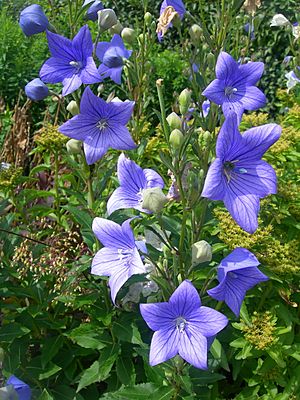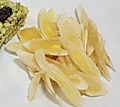Balloon flower facts for kids
Quick facts for kids Balloon flower |
|
|---|---|
 |
|
| Scientific classification | |
| Genus: |
Platycodon
|
| Species: |
grandiflorus
|
| Synonyms | |
|
Campanula gentianoides Lam. |
|
The balloon flower (scientific name: Platycodon grandiflorus) is a cool plant known for its unique flower buds. These buds swell up like little balloons before they open! It's also called the Chinese bellflower or just platycodon.
This plant is a perennial, which means it lives for more than two years. It's the only type of plant in its group, called the Platycodon genus. You can find it growing naturally in East Asia, including China, Korea, Japan, and parts of Russia.
Contents
What Does It Look Like?
The balloon flower can grow up to about 60 centimeters (2 feet) tall and 30 centimeters (1 foot) wide. It has dark green leaves and pretty blue flowers that bloom in late summer.
The most special part of this plant is its flower bud. Before it opens, it puffs up like a small balloon. When it finally opens, the five petals join together at the bottom, forming a bell shape. This is why it's also called a "bellflower," just like its relatives, the campanulas.
Where Does It Grow?
Balloon flowers are often found in mountains and open fields. They have thick roots and can grow between 40 to 100 centimeters (1.3 to 3.3 feet) tall. If you cut the stem, a white juice comes out. Their leaves are usually 5 to 12 centimeters (2 to 5 inches) long, with pointy ends and small teeth along the edges.
The flowers are usually purple or white and bloom in July and August. You might see one flower or several growing upwards from the top of the plant. The flower opens up into a bell shape with five parts.
You can find this plant all over Japan, China, the Korean Peninsula, and eastern Siberia.
How to Grow It
This plant is very tough and can survive cold winters, even down to -40 degrees Celsius (-40 degrees Fahrenheit)! It's often grown in gardens in many different climates.
In winter, the plant completely dies back, but don't worry! It grows back in late spring and then flowers in the summer. Even though the wild ones are usually blue, you can find garden varieties with white, pink, or purple flowers. In Korea, white flowers are quite common.
Some special types of this plant have even won awards for being great garden plants!
How People Use It
People use the balloon flower in many different ways, especially in East Asian cultures.
In the Kitchen
Korea
In Korea, the plant and its root are called doraji (도라지). The root is very popular and is used in many dishes. It can be fresh or dried.
It's one of the most common vegetables used in namul dishes, which are seasoned vegetable side dishes. You'll also often find it in bibimbap, a famous Korean mixed rice dish. Sometimes, people even cook rice with balloon flower root to make doraji-bap.
Before cooking, the root needs to be soaked and washed very well. People usually rub it with coarse sea salt and rinse it many times. This helps to get rid of its slightly bitter taste.
The root is also used to make sweet treats, like doraji-jeonggwa. You can also make a sweet syrup from the root called doraji-cheong, which can then be used to make doraji-cha (balloon flower root tea). Some people even use the root to make a special alcoholic drink called doraji-sul.
The roots are full of good things like calcium, fiber, iron, and vitamins. People often choose roots that are thick and have a strong taste.
For Health
People have used balloon flower roots in traditional medicine for a long time.
China
In traditional Chinese medicine, the Chinese bellflower (called 桔梗) is used as a cough suppressant and to help clear mucus. It's often used for common colds, coughs, sore throats, and chest congestion.
Korea
In Korea, the roots are commonly used to help with things like bronchitis, asthma, and other inflammatory conditions. Some people believe it can help reduce cholesterol. It is thought to be good for young children and older people who might have weaker immune systems, especially for breathing problems like asthma.
In Culture
Japan
In Japan, the bellflower is called kikyō (桔梗). It is one of the "Seven Autumn Flowers," which are special flowers celebrated in Japanese culture.
The kikyōmon ("Bellflower Seal" (桔梗紋)) is also a very important symbol. It's a crest or emblem used by certain families or clans, like a family badge.
-
The Seimei Kikyō is a pentagram symbol. It was used by a famous Japanese magician and diviner named Abe no Seimei.
Korea
Doraji taryeong (Korean: 도라지타령) is a very popular folk song in both North Korea and South Korea. It's also well-known among Koreans living in China, and even in Japan, where it's called Toraji.
This folk song originally came from a place called Eunyul in Hwanghae Province. However, the way it's sung today has changed over time. It now has the rhythm and tune of a Gyeonggi minyo, which is a type of folk song from the Gyeonggi Province.
See also
 In Spanish: Platycodon grandiflorus para niños
In Spanish: Platycodon grandiflorus para niños












